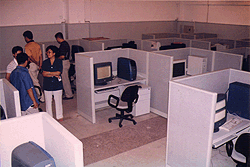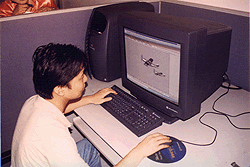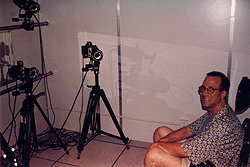Martin "Frank Gladstone recently traveled to China for a conference and two studio tours. Here he reflects on the experience of visiting a giant on the brink of taking a great leap.

On August first of this year, I was among about sixty people from the Hollywood film industry who traveled to China to take part in the 2000 Beijing Motion Picture and Television Conference, co-hosted by Legends of China, the China Society of Motion Picture & Television Engineers and Kodak China Ltd. The purpose of the Conference was to meet and discuss the movie industry with our contemporaries in China. Ideally, cinematographers would be able to meet cinematographers, costumers with costumers and animators with animators. The public format was to be open panel discussions, with more informal private discussions surrounding the three-day event.
Initially, I was there representing DreamWorks Animation but by circumstance and serendipity, I ended up being the only person directly representing animation, per se, at the Conference. Phil Feiner from Pacific Title, representing the digital services industry, moderated our panel, and our Chinese counterparts also came from the digital or traditional world.

Like many of the panels that occurred during the conference, most of the time was spent introducing each other and going over company history and purpose. This is a significant cultural aspect of presentations in China. Formal statements of past achievements and a listing of company assets are almost a requirement before any discussions can take place. Because of the limited time we had and the need to present these formal pronouncements and the interpretation into each other's language, the panel discussions very nearly always came to an end before any real discussion could happen.
That is not to say that issues did not come up. In several of the presentations, speakers were able to intertwine pressing matters into their narratives. In discussing the question of intellectual property, our Chinese speaker was most forthwith about the problem of piracy, even as he traced its history and possible solutions. Some discussion about royalties, the state of Chinese art direction and storytelling did manage to come through.
More interesting discussions happened outside of the main hall, where the participants could be less preoccupied with formalities. Here, we found our counterparts to be very frank, curious and candid about the crafts they share with us.
Beyond the Conference
But, in the end, it was not the Conference where I really got a look at what China is doing with animation. Yu Lee, the indomitable woman who put the conference together and did her best to keep it on track, realized some of my frustration at not having the opportunity to have more in depth discussions with animation personnel. She quickly arranged for me to visit the digital animation facilities in Beijing and Shanghai

Beijing is, of course, the bustling capital city of the People's Republic. The Science and Technology Digital Film Studio, located in a large building that houses several floors of film and film training divisions, seems to have a good deal of governmental support and perhaps a bit of bureaucratic counterpoise as well. The studio is well equipped with SGI workstations, various compositing and animation software (including Maya) and an adequate data center and film recorder. The operation is rather compact, broken into two large open plan areas with somewhere around thirty workstation cubicles in one, and a series of interconnected offices in the other. Part of the larger room is also cordoned off as a training area. Work has been pretty methodical at the studio. Their reel showed some good compositing technique, but all out animation was not yet evident.
The studio supervisor, Su Pingbao, was quick to mention that they are getting ready to expand and they are expecting much growth in facilities and capability over the next few years. I showed them some of DreamWorks product. They seemed very impressed and were almost apologetic about what they saw as their own humble efforts. They expressed a great deal of interest in learning more from us.

The following day, we traveled to Shanghai, perhaps the most cosmopolitan city in China. There, we visited the Shanghai Film Studio and were given a tour by the studio president, Zhu Yongde, and the director of operations, Eddie Lee. The Shanghai operation, while also tacitly supported by the government, has taken a very aggressive attitude toward digital production. Beginning in March of 1999, the studio prepared offices, bought and installed equipment (somewhere close to seventy workstations, a data center, film recorder and very extensive motion-capture stage) and software (Maya and Lightwave technologies), trained their crew and began producing 22 episodes of animation for television. Presently, they are in the midst of another series and are producing special effects for commercials and feature films as well. At the time we visited, they had just completed about nine minutes of digital work for a China-produced action-adventure film called Crash Landing. Their reel, especially for a studio so new, is impressive.

Shanghai, perhaps because of its more entrepreneurial history, its worldly, mercantile flavor, has generally a more aggressive outlook toward progress, driven, of course, by very ambitious studio leadership. What they have done in so short a time is remarkable, yet they too want to learn all they can, realizing, like their peers in Beijing, that they are really still in the midst of the training curve.
And they are quick to respond. We arrived a bit off the cuff, as the studio only learned we were coming the day before (which was actually the week-end). By the time we had toured the facility and were ushered into a room to look at the tape of DreamWorks animation I had brought along, the entire digital studio had been brought in and were waiting for us! It was a pleasure to talk with them.

Developing A Voice
So, how is animation in China? Well, I certainly cannot claim to know exactly the state of the industry there. I only saw two digital studios and did not have an opportunity to visit any other sites, either traditional or CG based. Even while the Beijing and Shanghai studios continue to grow and expand, other studios are in the works as well.
Nevertheless I did make it a point to stress that while having digital technology was important, it alone was not a "magic-box" that would somehow give China an edge in animation. In fact, I took pains to say that soon technology will be available everywhere (if it is not already) and that China must not only look to its expertise in mastering machines and software, but also find other ways to make their animation stand out from the rest, either in its economy, its mastery or, most importantly, in its ability to put across a story.
China has a long and beautiful narrative tradition and it has a soulful, creative and resourceful population. With the coming of the WTO and favored nation trading status with the United States, China will have even more of an opportunity to act as a contract entity, producing product initiated in other countries. That is all well and good (and something we all must recognize as our business becomes ever more globalized), but, if China really wants to make its mark in animation, I hope they will find a way to be more than contract labor, initiating their own projects designed to bring to the world some of the inventiveness and artistic tradition that is so much a part of the Chinese culture.
China is on the brink of a great transformation. For many hundreds of years it has been, for all intents and purposes, a feudal, isolated society. Now, at speeds that can make your head swim, it is beginning to emerge as a truly modern county, connected to the rest of the world. Not everything is in place yet but everywhere I looked the dichotomy between new and old was incredibly striking. (The image of a three-wheeled rickshaw driver talking on his cell phone comes to mind, almost as a metaphor.) There is much to do and much that will inevitably change, but the one sure thing is that the possibilities are tremendous.

About two weeks after my return to Los Angeles, Zhu Yongde and Eddie Lee from the Shanghai Film Studio visited DreamWorks. As I showed them around, peeking into some of the traditional as well as CG areas, Zhu Yongde's eyes widened. As we parted he said, with a great deal of enthusiasm, "Now I see. This is wonderful. You are not just involved with the technology here. For you, this is also art!" When China incorporates that kind of thinking into their animation, we should see some magnificent work indeed.
Frank Gladstone has been working as a professional animator, producer, director, writer and teacher for more than twenty-five years. For fifteen of those years, he managed his own award-winning studio and has since worked for the feature animation divisions at Disney, Warner Bros. and DreamWorks SKG. Besides his studio credentials, Frank has taught at animation schools and institutions around the country, in the Caribbean, Europe and Asia, including the University of Miami, VIFX, Cinesite, UNICEF Animation Workshops, Gnomon School of Visual Effects and UCLA. Currently, Frank is the Head of Artistic Development at DreamWorks SKG Animation.







